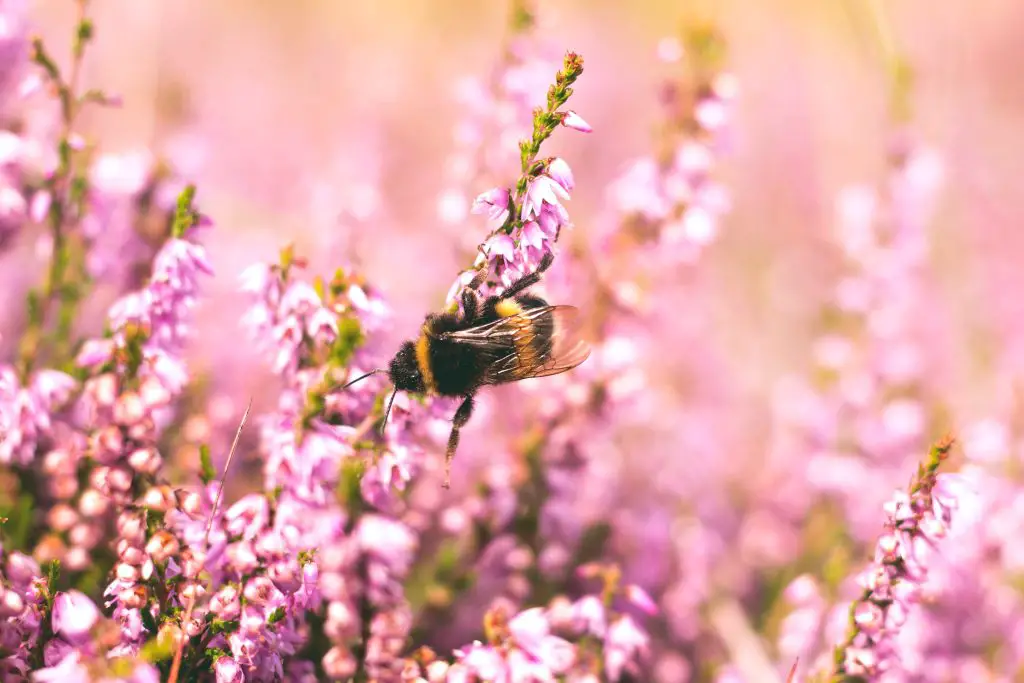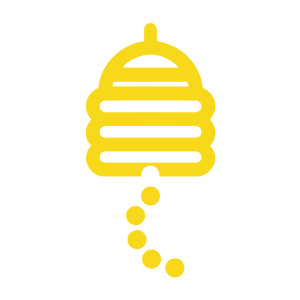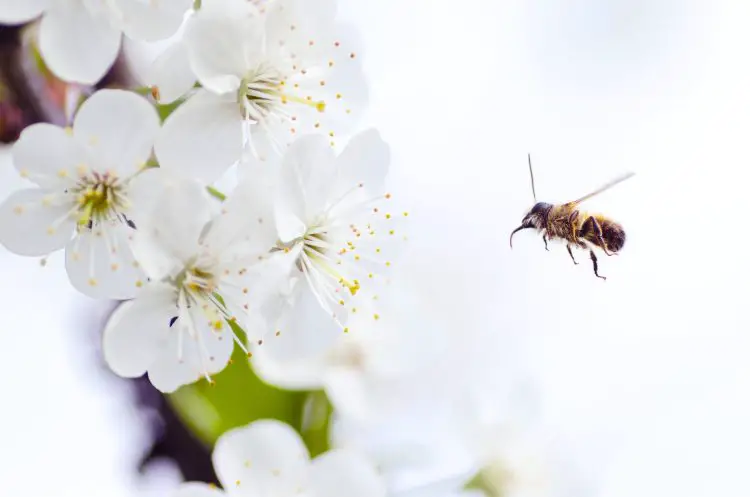Buzzing busily from flower to flower, bees play a vital role in our ecosystem. But amidst this vast family of buzzing insects, not all bees are designed to produce honey, a beloved sweet substance enjoyed globally. As we embark on this exploration, the focus sharpens on the honey bee, the master architect behind the liquid gold that graces our tables and enriches our culinary endeavors.
The type of bees that make honey are primarily honey bees, specifically the species Apis mellifera, commonly known as the European honey bee. Other species from the Apis genus also produce honey, such as the Asian honey bee (Apis cerana). It’s just 7 out of the roughly 20,000 bee species worldwide that produce harvestable honey.
In the realm of bees, only a selected few possess the incredible ability to transform nectar into honey. Navigate through the fascinating world of Apis mellifera and other honey-producing wonders from the Apis genus. Unfold the delicate dance these incredible creatures perform to gift us the delectable sweetness of honey.
Join us in delving deep into the bee universe, unraveling the sweet secrets of honey production and the remarkable bees that make it all possible. Welcome to the world where honey flows, and the air hums with the wings of the diligent honey-makers!
Do All Bees Make Honey?
Venturing into the world of bees uncovers a multitude of species, each with its distinct role and contribution to our ecosystem. But here’s the buzz – not all bees make honey. The assumption that every bee you spot is a honey maker is a common misunderstanding. So, who are the actual artisans behind this sweet, golden nectar?
Honey is Not Every Bee’s Business
Contrary to popular belief, the overwhelming majority of bee species do not produce honey. Out of around 20,000 known bee species in the world, only a few belong to the genus Apis, better known as honey bees. Honey bees are the ones blessed with the unique ability and societal structure to produce honey, a food source for their colonies and, luckily for us, a sweet treat enjoyed worldwide.
Bees from other genera, such as the solitary bees and most of the other social bees, do not produce honey. These bees have different lifestyles and priorities, focusing more on pollination and reproduction rather than honey production. Solitary bees, for example, do not live in colonies, and their life cycle doesn’t require the storage of large food supplies like honey.
For honey bees, however, honey production is a vital aspect of their survival. They produce and store honey to feed their colonies during the colder months when flowers are scarce, and nectar is not available.
Nectar Collectors vs. Honey Producers
Not all nectar collectors are honey producers. Many bee species collect nectar from flowers, which is a primary energy source for bees. The nectar fuels their flight and daily activities. However, only honey bees have the ability to transform this nectar into honey and store it for future use.
Honey bees convert nectar into honey through a process of regurgitation, enzymatic activity, and evaporation. Worker honey bees collect nectar from flowers and store it in their special honey stomachs. Enzymes in the honey stomach break down the nectar’s complex sugars into simpler forms. Back at the hive, bees deposit the nectar into the honeycombs, where they fan it with their wings to evaporate excess water, leaving behind the thick, sticky liquid known as honey.
The distinction between nectar collectors and honey producers is significant. While all honey bees are nectar collectors, not all nectar collectors are honey producers. Other bee species might collect and consume nectar, but they do not produce honey.
In essence, the world of bees is diverse and fascinating. Understanding the different roles and capabilities of various bee species, including their ability (or inability) to produce honey, provides a richer appreciation for these incredible insects and their vital contribution to our environment and food supply.

The Apis Bees
In the broad universe of bees, the Apis family uniquely stands out. These are the true, bona fide honey producers. Within the Apis genus, certain species are particularly notable for their honey-making capabilities and their crucial role in our ecosystems and agriculture. Let’s take a closer look at two prominent members: the European Honeybee (Apis mellifera) and the Eastern Honeybee (Apis cerana).
The European Honeybee (Apis mellifera)
Meet the Apis mellifera, more warmly known as the European Honeybee, the world’s most famous honey producer and pollinator. This bee species is a global traveler, having spread far beyond its original European homeland. It’s a prominent presence in North and South America, Africa, and parts of Asia.
The European Honeybee plays a significant role in pollinating crops, flowers, and other important plants. They have been domesticated and are kept by beekeepers worldwide for honey production and pollination. Each hive, home to thousands of these diligent workers, is a hub of continuous activity.
Honey production is a meticulous process for Apis mellifera. Worker bees forage for nectar, storing it in their special honey stomachs and later depositing it within the honeycomb cells of the hive. Here, the nectar undergoes a transformation, as bees fan their wings to evaporate its water content, leaving behind the thick, sweet substance we know and love.
Apis cerana, The Eastern Honeybee
Shifting the spotlight to Asia, meet Apis cerana, commonly known as the Eastern Honeybee or Asian Honeybee. Though smaller than its European cousin, the Eastern Honeybee is a robust and vital honey producer, particularly adapted to the diverse climates of the Asian continent, from the tropical south to the temperate north.
Apis cerana is a champion of adaptability. It has evolved strategies to defend against the menacing giant hornets that share their Asian habitat, demonstrating coordinated group defense mechanisms that are a sight to behold.
The Eastern Honeybee also plays a vital role in local ecosystems as a proficient pollinator and is crucial to the production of various Asian crops. As with Apis mellifera, Apis cerana worker bees collect nectar, convert it to honey, and store it within the hive for future use. Their honey, like that of the European Honeybee, is harvested for human consumption and is a cherished natural sweetener.
Which Species of Bees Make Honey?
Dive into the world of bees and you’ll soon discover a marvelous variety, from the solitary carpenter bee to the communal bumblebee. But amidst this diverse bee universe, only a select few have the distinct ability to produce honey. Unveiling the mystery: it’s predominantly the bees belonging to the genus Apis, commonly known as honey bees, that are the true architects behind the luscious, golden honey we enjoy.
Apis Genus [The Unmatched Honey Makers]
Bees within the Apis genus are remarkably adapted to honey production. They gather nectar from flowers, which is then transformed into honey through a meticulous process involving nectar collection, regurgitation, evaporation, and storage within the unique hexagonal wax structures of the beehive. This honey is not just a delightful treat for humans; it’s a crucial food source for the bees, providing sustenance during the colder months when fresh flower nectar is scarce.
List of Bee Species Which Make Honey
Though honey-making is largely confined to the Apis genus, there’s variety within this group, each species having its unique characteristics, habitats, and honey-producing capabilities. Below is a list of some bee species renowned for their honey-making skills:
1. European Honeybee (Apis mellifera)
- Region: Worldwide
- Honey Production: High
- Notable Features: Most commonly kept by beekeepers globally
- More Information: Australian Government: Agriculture
2. Eastern Honeybee (Apis cerana)
- Region: Asia
- Honey Production: Moderate
- Notable Features: Smaller than Apis mellifera, adapted to various Asian climates
- More Information: Australian Native Bee
3. Giant Honeybee (Apis dorsata)
- Region: South and Southeast Asia
- Honey Production: Moderate to High
- Notable Features: Large size, can build massive honeycombs
- More Information: National Geographic
4. Dwarf Honeybee (Apis florea)
- Region: Asia and the Middle East
- Honey Production: Low
- Notable Features: Very small size, builds open nests
- More Information: National Geographic
5. Apis koschevnikovi (Koschevnikov’s Bee)
- Region: Borneo, Malaysia, and Indonesia
- Honey Production: Low to Moderate
- Notable Features: Resilient to tropical weather conditions
- More Information: BuzzAboutBees
6. Apis nigrocincta (Sundaland Honey Bee)
- Region: Indonesia and Philippines
- Honey Production: Low
- Notable Features: Adapted to equatorial lowland forests
- More Information: IUCN Red List
7. Apis andreniformis (Black Dwarf Honey Bee)
- Region: Southeast Asia
- Honey Production: Low
- Notable Features: Smaller, and black in color
- More Information: GBIF
While each of these species has the capability to produce honey, the amount they produce and the practicality of harvesting that honey vary widely. Many of these bee species are not used in commercial honey production because they produce limited quantities of honey, their hives are difficult to manage, or they may have aggressive behaviors that make them unsuitable for domestication.
Bees like the Western honey bee (Apis mellifera) and the Eastern honey bee (Apis cerana) are the main honey producers that are widely domesticated for commercial honey production because of their high honey output, relatively gentle nature, and ease of management.
In essence, while various bee species can create honey, the commercial production of honey predominantly revolves around a select few that have proven to be efficient and manageable producers.

Bumblebee Honey
When discussing honey and bees, it’s pivotal to shine a light on the bumblebee’s role in this sweet saga. While renowned for their robust pollinating skills and distinctive buzz, bumblebees’ relationship with honey is vastly different compared to their honeybee counterparts.
The Bumblebee’s Unique Nectar
Bumblebees, belonging to the genus Bombus, do collect nectar and produce a honey-like substance. However, it’s important to understand that this nectar is not the same as the honey produced by honeybees in the Apis genus. The nectar gathered by bumblebees is stored in tiny pots within their nest, used as a food source for the colony, including the young and the queen.
This nectar does not undergo the extensive evaporation process that honeybee nectar does, which means it has a much higher water content and is not as thick or sticky as traditional honey. This high moisture content makes bumblebee nectar less suitable for long-term storage and it is generally consumed by the bumblebee colony shortly after production.
Why Bumblebees Don’t Make Honey Reserves
The bumblebee lifestyle explains why they do not create significant honey reserves like honeybees. Bumblebee colonies are much smaller, typically housing only a few hundred individuals, compared to the tens of thousands in a honeybee colony. This smaller colony size reduces the need for large food storage, as bumblebees do not overwinter as a colony and thus don’t require extensive food reserves for survival during cold months.
Additionally, bumblebee colonies are annual, meaning a new colony is established each year by a young, mated queen. This queen, after overwintering, starts a new nest in the spring, lays eggs, and raises the first batch of worker bees. Once the worker bees are mature, they take over the foraging duties, bringing nectar and pollen back to the nest to feed the next generation. The colony reaches its peak in late summer, after which it produces new queens and males for mating, and the cycle begins anew. The old queen and her workers die off, and no substantial honey stores are needed for their survival over the winter.
In conclusion, while bumblebees do produce a nectar-like substance, their unique lifestyle and colony structure mean they do not produce honey in the same way or volume as honeybees. Understanding these distinctions is essential in appreciating the diverse roles different bees play in our ecosystem and in honey production.

Bees that Make Honey in the USA
In the vast and varied landscapes of the USA, buzzing amidst the flowers and foliage, you’ll find bees of all sorts, each playing its unique role in the ecosystem. Among this buzzing bounty, some specific bee species take the spotlight for their honey-making capabilities. Let’s delve into the world of American honey producers and explore the ones that have a significant presence in the USA.
The Prolific European Honeybee in the USA
Despite its European origins, the European honeybee (Apis mellifera) has firmly rooted itself in American soil and is now the most significant honey producer in the USA. It was introduced to North America in the early 17th century and quickly became a beloved and valuable asset, pollinating a multitude of crops and producing abundant honey.
The Apis mellifera has various subspecies, with different regions in the USA favoring different types. For example, the Italian honeybee (Apis mellifera ligustica) is popular among beekeepers for its gentle nature and prolific honey production.
In the United States, the honey industry is substantial, contributing billions to the economy and providing jobs, both in honey production and in the related field of pollination services. The European honeybee is the star player in this industry, buzzing about in fields from coast to coast and producing millions of pounds of honey annually.
Native American Honey Producers
While the European honeybee holds a dominant place in American apiculture, it’s crucial to acknowledge the role of native bees. The USA is home to several thousand bee species, though most are not significant honey producers. However, some native bee species, like the different varieties of stingless bees (Meliponini) in warmer regions, do produce honey.
Stingless bees have been kept for honey production by indigenous peoples in Central and South America for centuries. In the warmer areas of the USA, like Florida and southern Texas, these tiny bees also contribute to local honey production, though on a much smaller scale compared to the European honeybee. They create unique and flavorful honey, which is cherished in local communities.
Stingless bee honey is known for its unique flavors and potent medicinal properties, and it is an esteemed delicacy in many regions. These small but mighty bees remind us that honey production is not just the realm of the more prominent and more familiar bee species, but a craft mastered by various bee species across the diverse American landscapes.
In conclusion, while the European honeybee reigns supreme in US honey production, the contribution of native bee species, including the stingless bees, adds a rich layer of diversity to the American honey story. Together, these bees weave a tale of sweetness and sustenance across the USA.

Bees that Make Honey in the UK
Navigating through the rolling landscapes and lush gardens of the United Kingdom, one encounters a rich tapestry of biodiversity, and bees play an invaluable role in this dynamic ecosystem. The UK holds a longstanding love affair with honey and the bees that produce this golden nectar. Let’s explore the honey-making bees in the UK and the nation’s enthusiasm for local and regional honey.
Main Honey-making Species in the UK
In the UK, the predominant honey-producing bee is the European honeybee (Apis mellifera). Different subspecies of the Apis mellifera are utilized, with the most common in the UK being the European Dark Bee (Apis mellifera mellifera). These hardy bees are well-suited to the variable British climate, proving resilient and adaptable to different weather conditions.
Beekeeping has a rich history in the UK, with both amateur and professional beekeepers contributing to the country’s honey production. In addition to the European honeybee, the UK is home to a wide array of native bee species, many of which also collect nectar but do not produce honey in any significant quantity. Nevertheless, their role in pollination is essential, supporting the growth of flora and contributing to the biodiversity that is crucial for a balanced and healthy ecosystem.
The UK’s Passion for Local and Regional Honey
There’s a unique bond between the British and their honey. The UK’s diverse geography, from the heather-covered highlands of Scotland to the floral meadows of the English countryside, offers a myriad of unique nectar sources, each imparting distinctive flavors and properties to the honey produced. This results in a wealth of regional honey varieties, each celebrated for its individual character and taste.
Locally produced honey is deeply cherished in the UK. Many Britons have a penchant for honey that’s sourced close to home, relishing the connection to their local environment and the assurance of quality and purity that comes with it. Farmers’ markets and local stores often carry an array of regional honeys, each with its own loyal following of enthusiasts who treasure the unique flavors and the touch of locality infused in each jar.
Artisanal and small-scale honey production is thriving in the UK, with an increasing number of individuals and communities engaging in beekeeping. This not only boosts local economies and promotes sustainability but also fosters a growing awareness and appreciation for bees and their vital role in the environment.
In essence, the honey-making bees and the passionate beekeeping community in the UK contribute to a vibrant honey culture, characterized by diversity, quality, and a deep-rooted connection to the land and its blossoming treasures.

Tropical Honey Bee Species
Venture into the lush and warm climates of the world’s tropics, and you’ll be met by a stunning display of biodiversity, a place where the air is filled with the hum and buzz of countless insects, including various bee species. The tropical regions of our planet host a unique set of honey bee species, each adapting to the specific challenges and benefits of life near the equator. Let’s explore some tropical honey bee species and the distinctive honey they produce.
In places like Brazil, Mexico, and Indonesia, local and indigenous communities have been harvesting and enjoying the delectable nectars of their native bees for generations. Tropical honey varieties such as those produced from coconut blossoms, acacia flowers, and other exotic plants offer a delightful departure from the more familiar honey flavors, introducing palates to a world of diverse and intriguing tastes.
Stingless Bees
In the warm, vibrant environments of the tropics, stingless bees (from the tribe Meliponini) take center stage as essential honey producers. These petite bees, found in various parts of Africa, Australia, and Central and South America, come in numerous species, each uniquely adapted to their particular tropical habitat.
Despite their small size and lack of a stinger for defense, stingless bees are skilled and efficient foragers and pollinators, playing a crucial role in maintaining the health and diversity of tropical ecosystems. They build their hives in a variety of locations, from underground to tree trunks, crafting intricate structures that protect their colonies and their precious honey stores.
The honey produced by stingless bees, known as “meliponine honey,” is highly prized for its unique flavors, varying acidity, and a rich array of medicinal and nutritional properties. In many tropical communities, stingless bee honey holds a special cultural significance, regarded not only as a delightful sweetener but also as a healing and nourishing substance.
The Asian Honey Bee (Apis cerana)
In the vast and diverse landscapes of Asia, particularly in the southeastern regions, the Asian honey bee, or Apis cerana, thrives. This bee is smaller than its European counterpart (Apis mellifera) and has adapted beautifully to the tropical and subtropical climates of Asia.
Apis cerana is a resilient and resourceful species, demonstrating impressive foraging skills and adaptability to various environmental conditions. It produces honey that reflects the diverse flora of the Asian tropics, offering a unique taste profile that captures the essence of the region’s rich botanical offerings.
Giant Honey Bees (Apis dorsata)
The giant honey bees (Apis dorsata) add to the spectacle of tropical bee species. Predominantly found in South and Southeast Asia, these bees are known for their large size and the impressive open-air nests they build on tall trees and cliffs. The honey harvested from Apis dorsata colonies is valued for its complex flavors, reflective of the wide array of nectar sources these bees visit in their tropical habitats.
African Honey Bees
Africa, with its expansive landscapes and abundant wildlife, is home to various bee species, including the African honey bee (Apis mellifera scutellata). Adapted to the warm climates of the African continent, these bees are known for their hardiness and productivity in honey production. African honey bees produce honey with diverse and robust flavors, echoing the continent’s rich floral diversity.
Protecting the Tropical Honey Bees
Amidst the delight in the unique honey varieties that tropical bees produce, it’s crucial to focus on the conservation of these vital pollinators. Habitat loss, climate change, and other environmental pressures pose significant threats to tropical bee species. Ensuring the protection and preservation of their habitats is essential for maintaining the balance of tropical ecosystems and continuing the production of the diverse and distinctive honeys these regions are celebrated for.
In conclusion, tropical honey bees, with their myriad species and distinctive adaptations, paint a colorful and vibrant picture of life in the world’s warmest regions. Their contribution to biodiversity, ecosystem health, and human enjoyment through their honey production is immeasurable. As we indulge in the delectable and diverse world of tropical honey, let us commit to safeguarding these precious bees, ensuring they continue to thrive and enchant in the tropical realms they call home.

Honey Differences Between Honey-Making Bee Species
In the diverse world of honey, you’ll discover a delightful array of tastes, textures, and nutrient profiles. The differences in honey characteristics arise from the variety of bee species and the distinct environments they inhabit. Let’s explore the variances in honey based on the bee species that produce it, factors that affect taste and texture, and the nutritional content of the honey.
Taste and Texture
Each honey-making bee species creates honey with a distinct taste and texture, reflecting the unique environments and floral sources they access. For instance, honey from the Asian honey bee (Apis cerana) typically has a different flavor profile compared to honey from the European honey bee (Apis mellifera), owing to the diverse flora in their respective habitats.
Stingless bees produce honey that is often more liquid in texture, with a tangy taste that sets it apart from the honey produced by other bee species. The giant honey bees (Apis dorsata) offer honey with complex flavors, mirroring the array of nectar sources they visit in their tropical surroundings.
What Factors Affect Taste and Texture?
Several factors influence the taste and texture of honey:
- Floral Source: The types of flowers bees visit for nectar significantly affect the honey’s flavor, texture, and even color. Different plants produce nectar with varying sugar compositions, flavors, and fragrances, all of which are transferred to the honey.
- Geographical Location: The geographical area where bees forage impacts the honey characteristics due to the diversity of flora available. Regional climate and soil type also influence the types of plants that thrive in the area, and subsequently, the honey’s taste and texture.
- Season: Different plants flower at different times of the year, offering a variety of nectar sources across seasons, and contributing to the seasonal variations in honey flavor and consistency.
- Bee Species: Different bee species have unique foraging behaviors and preferences, leading to variations in the floral sources they access and the honey they produce.
Nutritional Content
The nutritional content of honey also varies based on the bee species and their foraging patterns. Generally, honey is a rich source of natural sugars (fructose and glucose), and it contains small amounts of vitamins, minerals, and antioxidants. However, the exact nutritional composition depends on the specific flowers the bees have visited.
For example, honey produced by stingless bees is noted for its high antioxidant content compared to honey from other bee species. This attribute is linked to the tropical and sub-tropical flowers these bees predominantly forage on, which are rich in beneficial compounds.
While honey from different bee species varies in taste, texture, and nutritional content, each type of honey offers a unique and enjoyable sensory experience and a host of nutritional benefits. Appreciating these differences enhances the honey tasting experience, allowing us to savor the diverse gifts that various bee species bring to our tables and our lives.
Differences in Honey Due to Foraging and Procedures of Bee Species
When we think of honey, the lush, golden syrup that the honey bee produces might spring to mind. However, the world of honey is a mosaic of flavors, colors, and consistencies, each uniquely crafted by different bee species through their distinct foraging habits and honey-making procedures.
Foraging Habits and Their Influence on Honey
 Floral Preferences
Floral Preferences
Different bee species have varying floral preferences. For example, the European honey bee (Apis mellifera) has a wide range of flowers it can forage from, which leads to diverse types of honey, such as clover, lavender, and acacia honey. On the other hand, stingless bees, particularly in the tropics, might focus on specific types of flowers, leading to honey with distinct, bold flavors and higher nutritional values.
 Foraging Range
Foraging Range
The distance bees travel to forage also impacts the honey’s characteristics. Some bees, like the African honey bee, have a larger foraging range, potentially accessing a more extensive variety of flowers. This factor can lead to honey with a complex amalgamation of flavors and nutrients from various floral sources.
 Foraging Time
Foraging Time
Bees also have different foraging times. Some species prefer foraging at dawn or dusk, aligning with the blooming times of certain flowers. This habit again affects the type of nectar they collect and the resultant honey’s flavor and nutritional profile.
Honey Production Procedures
The way each bee species processes nectar into honey is another key differentiator. The Asian honey bee (Apis cerana) and the European honey bee (Apis mellifera) process nectar similarly but have slight variations in nectar reduction and honey storage within the hive, influencing the honey’s moisture content and flavor intensity.
Hive and comb construction also play a significant role. For instance, stingless bees create hives with different structures and materials compared to other bee species, impacting honey’s taste and texture.
The use of various materials in hive construction, such as resins and mud, can impart additional flavors and properties to the honey.
Bees have adapted their honey-making procedures to their specific environments. For example, bees living in humid climates have evolved methods to reduce the moisture content of their honey more efficiently, leading to thicker honey.
This adaptation affects both the texture and the preservation qualities of the honey.
The Multifaceted World of Honey Bees
The diverse world of honey-making bee species is an exquisite dance of nature, showcasing the harmony of bees, flowers, and environments. From the ever-industrious European honey bee (Apis mellifera) to the specialized stingless bees of the tropics, each species contributes uniquely to the global mosaic of honey.
The differences in foraging habits, hive constructions, and environmental adaptations among bee species carve out a delightful and multifaceted landscape of honey varieties.
Every jar of honey reflects a particular community of bees, a specific swath of flora, and the unique environmental conditions of a region. The delicate flavors, aromatics, and nutritional richness of these different honeys are a testament to the bees’ unparalleled skill and the ecological webs they inhabit.
In Conclusion
The world of honey-making bees is a microcosm of nature’s brilliance, showcasing resilience, adaptability, and the delicate balance of life. Each jar of honey is a tribute to the tireless work of bees and a reminder of our responsibility to safeguard their existence. Let’s continue to marvel at, and support, these remarkable creatures, ensuring that the sweet legacy of honey-making bees endures for generations to come!
Frequently Asked Questions About Honey-Making Bees
Can other types of bees, besides honey bees, produce honey?
While primarily honey bees (species within the Apis genus) are known for producing honey, some other bee types, like bumblebees (genus Bombus), do produce a honey-like substance. However, this is in much smaller quantities and is not harvested or consumed by humans like honey bee honey. Bumblebee honey is different in composition and is consumed quickly by the colony due to its high water content and lower shelf life.
Why do honey bees make honey, and how much can a hive produce in a year?
Honey bees make honey as a food source to sustain the colony, especially during winter when nectar is scarce. A single hive can produce anywhere from 20 to 60 pounds of surplus honey per year, though this can vary greatly depending on factors like the hive’s health, local flora, and weather conditions. Some highly productive hives can produce over 100 pounds of surplus honey in a good year.
Is the honey produced by different species of bees different in taste or quality?
Yes, the honey produced by different bee species can vary significantly in taste, texture, and nutritional properties. These variations are due to differences in the floral sources the bees forage from, regional climatic conditions, and the unique honey-making processes of each bee species. For example, honey from the Asian honey bee (Apis cerana) may have a different flavor profile compared to that from the European honey bee (Apis mellifera), reflecting the diverse flora of their respective habitats.


![3 Big Mistakes Beginner Beekeepers Make [And How To Avoid Them!]](https://beekeepingabc.com/wp-content/uploads/2020/11/3-mistakes-beginner-beekeepers-make-90x75.jpg)

![Move over ducks, Queen Bees quack too! [Here’s Why]](https://beekeepingabc.com/wp-content/uploads/2020/06/queen-bee-90x75.png)
![The Flow Hive 2 Review [ Vs. The Classic Flow Hive]](https://beekeepingabc.com/wp-content/uploads/2020/02/Flow-Hive-2-90x75.jpg)
![How Bees Fly [10 Facts About How, When, and Why]](https://beekeepingabc.com/wp-content/uploads/2019/12/A-Bee-Flying-90x75.jpg)